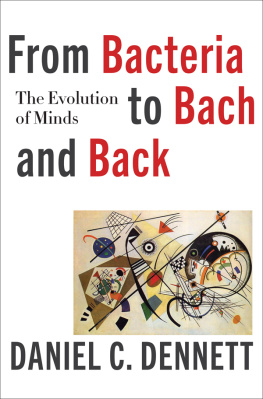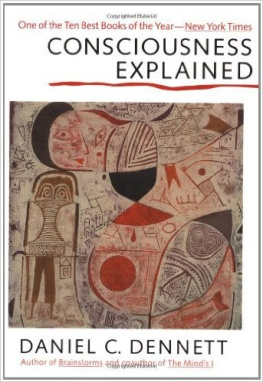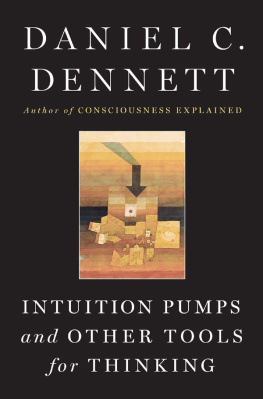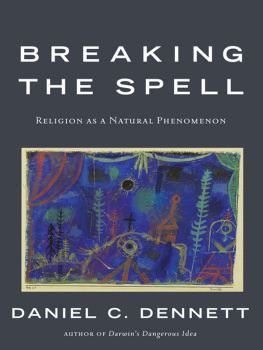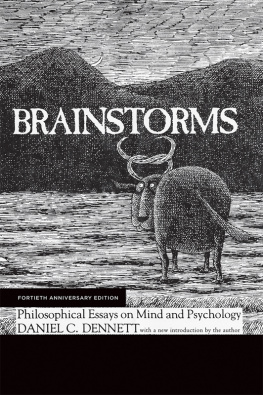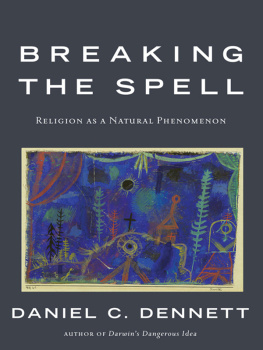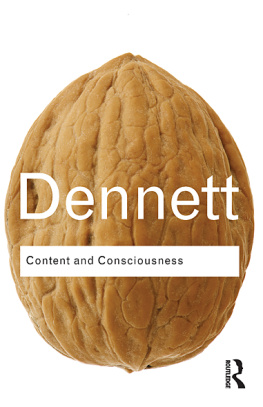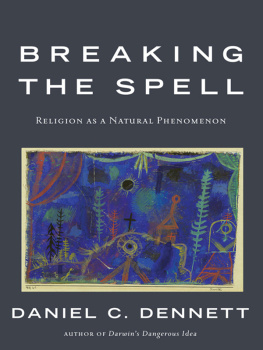TheIntentional Stance
Daniel C. Dennett
ABradford Book The MIT Press Cambridge, Massachusetts London, England
Seventh printing, 1998
First MIT Press paperbackedition, 1989
1987 by The MassachusettsInstitute of Technology
All rights reserved. No part ofthis book may be 'eproduced in any form by any electronic or mechanical means(including photocopying, recording, or information storage and retrieval)without permission in writing from the publisher.
This book was set in Palatino byAchorn Graphic Services and printed and bound in the United States of America.
Library of CongressCataloging-in-Publication Data
Dennett, Daniel Clement. Theintentional stance.
"A Bradford book."
Bibliography: p.
Includes index.
1. Intentionality (Philosophy)I. Title. B105.I56D46 1987 128'.3 87-3018
ISBN 0-262-04093-X (hardcover)0-262-54053-3 (paperback)
Dedicated to the memory
of Basil Turner,
neighbor, friend, and teacher.
{viii}
Contents
Preface ix
1 Setting Off on the Right Foot
2 True Believers
3 Three Kinds of Intentional Psychology
4 Making Sense of Ourselves
5 Beyond Belief
6 Styles of Mental Representation
7 Intentional Systems in Cognitive Ethology:The "Panglossian Paradigm" Defended
8 Evolution, Error, and Intentionality
9 Fast Thinking
10 Mid-Term Examination: Compare and Contrast
Bibliography
Index
{ix}
Preface
Thetheory of intentionality presented in this book has been gradually evolvingover about twenty years. While the central ideas found rudimentary expressionin Content and Consciousness in 1969, it was the publication in 1971 of"Intentional Systems" that initiated the series of articles aboutwhat I call the intentional stance and the objects one discovers from thatstance: intentional systems. The first three of these articles (Dennett 1971,1973, 1976b) were reprinted in Brainstorms in 1978, and critics andstudents often treat that book as the canonical, target expression of my view.I soon found, however, that the defense of my position was evolving further inresponse to criticism, and so I was driven to compose a series of post-Brainstormsessays in which I attempted to revise, re-express, and extend my view.
Most ofthese essays were scattered, however, in relatively inaccessible volumes,thanks to the inexorable effect of Limelight Gravity: as one's ideas become aCenter of Attention, one is invited to contribute to more and more conferences,which proceed to suck one's entire corpus into delayed publication inconference proceedings and special-interest anthologies. Nothing is left overto submit to refereed journals, for ready reading. The point of this book is toovercome the bad side effects of that otherwise gratifying diffusion.
Six ofthose scattered essays are reprinted in this volume (chapters 2-7), introducedby an essay on their aspirations and methodological presuppositions, tiedtogether with reflections, and followed by two new essays (chapters 8 and 9),in which the themes and arguments of the preceding chapters converge on somerather surprising claims about the relationship between evolution, braindesign, and intentionality. Chapter 10 is my attempt to adopt the stance of animpartial observer toward my own work and describe its place in the developmentof current thinking about "the intentionality of mental states." {x}
This bookdoes not present my whole view of the mind, but only, one might say, the firsthalf: content. The other half consciousness is also in need of a secondretelling (part three of Brainstorms was the first), but that willrequire another volume, to which I am currently devoting my attention.Consciousness is regularly regarded, especially by people outside the field ofphilosophy, as the outstanding (and utterly baffling) challenge to materialisttheories of the mind. And yet, curiously enough, most of the major participantsin the debates about mental content to which this volume is primarilyaddressed have been conspicuously silent on the topic of consciousness. Notheory, or even theory-sketch, of consciousness is to be found in the writingsof Fodor, Putnam, Davidson, Stich, Harman, Dretske, or Burge, for instance. I,on the other hand, do have a theory of consciousness (and have always haddifficulty understanding how the others can suppose they may ignore or postponethe issue), but its latest version is too unwieldy for inclusion in thisvolume. Anyone impatient to see how the new version of this second half of mytheory of the mind comes out can extrapolate (at my own risk) from the ideasexpressed in such published and forthcoming essays as "How to Study HumanConsciousness Empirically: or, Nothing Comes to Mind" (1982b), "WhyDo We Think What We Do About Why We Think What We Do?" (1982d),"Reflection, Language and Consciousness" (Elbow Room, 1984d,pp. 34-43), "Julian Jaynes' Software Archeology" (1986d),"Quining Qualia" (forthcoming d), and "The Self as the Center ofNarrative Gravity" (forthcoming g).
Anotherchallenge, also popularly deemed insurmountable by materialistic theories ofthe mind, is the problem of free will. I have devoted a separate book to thatchallenge, Elbow Room, so the topic will scarcely be mentioned again inthese pages. If there are other major challenges to my view, they have not yetbeen drawn to my attention.
Since thepreviously published essays in this volume appeared over a five-year span,punctuated by their share of controversy, misconstrual, and amendment, it is nowonder that few have been able to discern the resulting equilibrium position. Ihave sometimes been described, in fact, as presenting a moving target to mycritics. There is some truth to this. I have been ready to learn from mymistakes and willing to retract ill-considered claims. Motion is relative,however, and when something appears to an observer to be protean and wandering,it may be because the observer is only gradually coming to {xi} discern the shape it has had all along. Recently I was congratulated by aneuroscientist for "coming around" to a view I have unswervinglymaintained since Content and Consciousness in 1969, a soberingexperience that has led me to reassess my expository strategy over the years.Rereading that book, now in paperback after being out of print for some years,I am struck more by my doctrinal constancy than by my developments. Most of thechanges seem to me to be extensions, extrapolations, and further arguments, notshifts. Be that as it may, I have probably seriously underestimated thepotential for misdirection in my playful and unsystematic style. In this book Ido my best, therefore, to come to a halt, draw my wagons into a circle, andpresent and defend my considered view in a more orderly fashion.
Some ofthe previously unpublished parts of this book are drawn from my Gavin DavidYoung Lectures at the University of Adelaide in 1984, from my lectures at theEcole Normale Superieure in Paris in 1985, and from lectures given at variousworkshops, conferences, and colloquia in the last two or three years, fromwhich I gained a bounty of insights that have found their way into this volume.
I am alsograteful to many people for advice and criticism on earlier drafts of theunpublished material in this volume: especially to Kathleen Akins, who not onlyhelped organize and edit the entire book, but also convinced me to make majorrevisions in the presentation and defense of my views; and to Peter Bieri, BoDahlbom, Debra Edelstein, Doug Hofstadter, Pierre Jacob, Jean Khalfa, DanLloyd, Ruth Millikan, and Andrew Woodfield. I am also very pleased to add myvoice to the now traditional chorus of authorial praise for my good friendsHarry and Betty Stanton, who have made me so proud, over the years, to be aBradford Books author. And thanks, as always, to my wife Susan for her supportand forbearance, and to my colleagues at Tufts.
Next page

